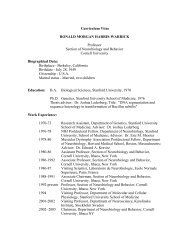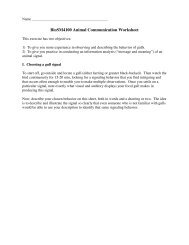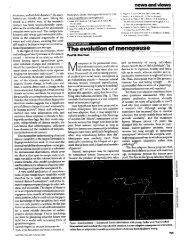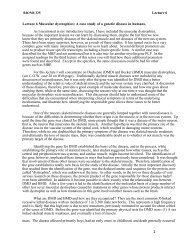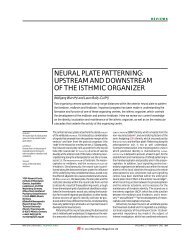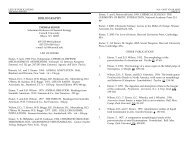Evolutionary Biology of Insect Learning - Department of ...
Evolutionary Biology of Insect Learning - Department of ...
Evolutionary Biology of Insect Learning - Department of ...
Create successful ePaper yourself
Turn your PDF publications into a flip-book with our unique Google optimized e-Paper software.
Annu. Rev. Entomol. 2008.53:145-160. Downloaded from arjournals.annualreviews.orgby CORNELL UNIVERSITY on 02/08/08. For personal use only.Speciation: theformation <strong>of</strong> a newbiological speciesobserver ant, a model ant moves from the nestto the food source 25% slower than when travelingalone. The model ant adjusts her speed,slowing down when the observer ant is delayedand accelerating when the observer isfollowing closely. Tandem running in the antT. albipennis was formally described as a case<strong>of</strong> teaching (49), which is a highly restrictivecategory <strong>of</strong> social learning. Currently, onlyone other case <strong>of</strong> teaching in nonhuman animalshas been confirmed (107). In addition torecruiting nestmates to distant food sources,social bees can also copy the flower choice<strong>of</strong> experienced foragers. Experiments in twolaboratories indicated that inexperienced observerbees (Bombus spp.) were more likely toland on the flower type visited by model beesthan on an unvisited alternative (64, 121).PROSPECTSThis review indicates that a variety <strong>of</strong> insectsrely on learning to enhance all major life activities,including feeding, antipredatory behavior,aggression, social interactions, courtship,and mate choice. Given that insect learningis now well documented, future research canfocus on a variety <strong>of</strong> topics concerned withthe evolution <strong>of</strong> learning and with the effects<strong>of</strong> learning on insect ecology and evolution.These issues are outlined below.Ecological Variables Associated withEnhanced <strong>Learning</strong> AbilitiesThere is widespread interest in the evolution<strong>of</strong> learning, cognition, and intelligence.To this end, work on vertebrates has successfullyidentified positive correlations betweenspecific ecological needs and either thenecessary learning abilities required to meetthese needs or the relative volumes <strong>of</strong> specificbrain parts housing the cognitive traitsthat process these needs (34). The strikinglack <strong>of</strong> comparable data from insects indicatesthat research is biased toward vertebratesor that negative data have remained unpublished.There is a large interspecies variationin the relative size <strong>of</strong> brain parts such as themushroom body (104), but that variation hasnot yet been tightly linked to insect learningand ecology. Fruitful lines <strong>of</strong> research withinthis area include testing the predictions that(a) nesting insects that shuttle between theirnest and food sources would have better spatiallearning and memory than closely relatednonnesting species (31), (b) social learning andbehavioral flexibility (innovation) are associatedwith larger volumes <strong>of</strong> relevant brainparts such as the mushroom body (66, 93), and(c) nectar feeders would be less likely to exhibittaste-aversion learning than would closely relatedfoliage feeders (90). A related promisingresearch program should examine the neurogeneticmechanisms underlying betweenspeciesvariation in learning and memory abilities(101, 122).Effects <strong>of</strong> <strong>Learning</strong> on Speciationin <strong>Insect</strong>sBehavior in general and learning in particularmay be major forces driving speciation (9, 74,119). This widespread assertion, however, isnot yet broadly supported by theory or data(34). <strong>Insect</strong>s have been employed extensivelyin the study <strong>of</strong> speciation (24, 59, 69) and couldreadily be used for critical tests <strong>of</strong> the role <strong>of</strong>learning in speciation.<strong>Insect</strong> learning can contribute to speciationin at least two ways. First, if adultscan learn to seek the substrate they fed onas larvae, and if adults typically mate atthe substrate, the resulting assortative matingcould lead to speciation (108). At least inD. melanogaster, parts <strong>of</strong> the mushroom body,the brain part involved in olfactory learning,remain intact during metamorphosis, potentiallyallowing memory to be maintained fromlarvae to adults (8). A few reports have indicatedthe transfer <strong>of</strong> memory from larvae toadults (53, 92, 111). Furthermore, two alternativelearning scenarios do not require memorythrough metamorphosis. First, in some insects,the larvae pupate next to the substrate;therefore eclosing adults can learn directly the154 Dukas



